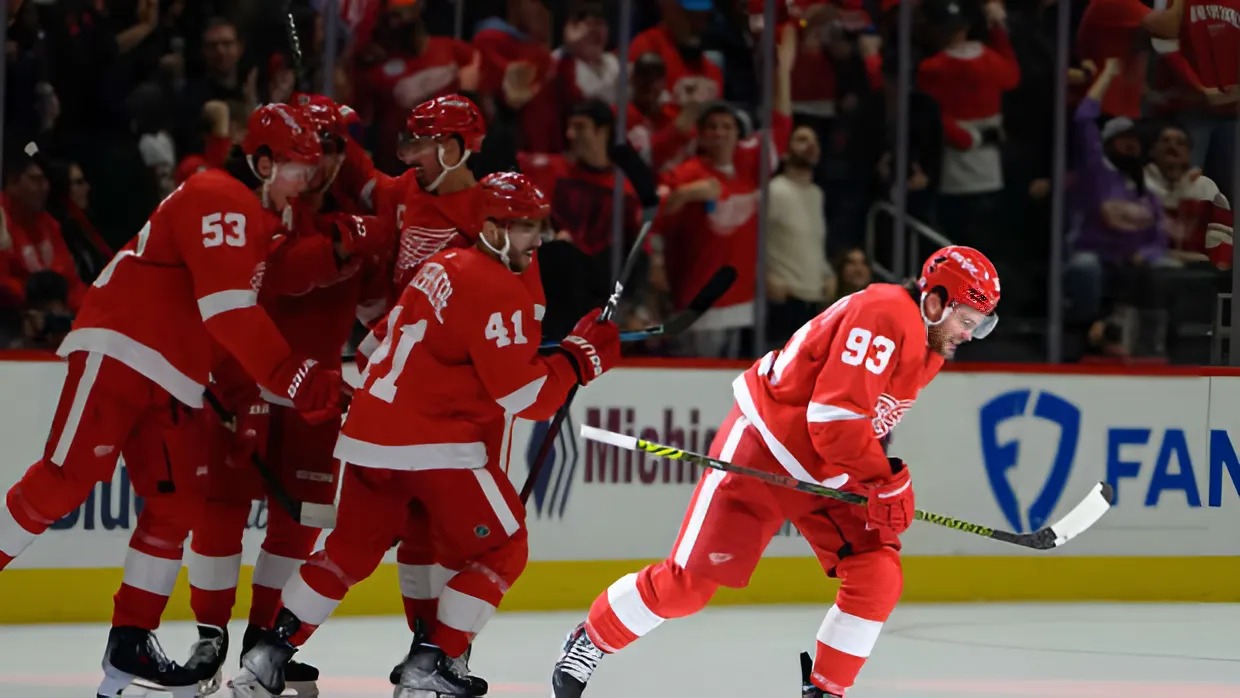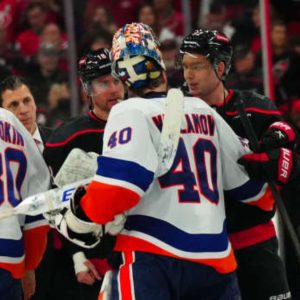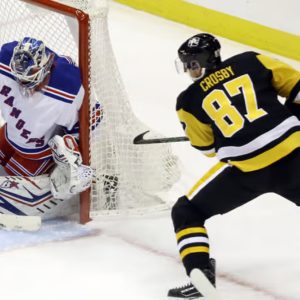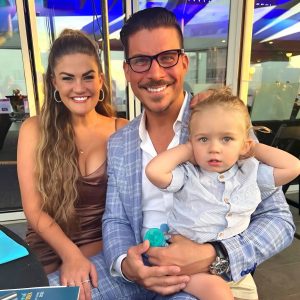This offseason has seen anything but stability when it comes to the Detroit Red Wings’ power play options.

After Detroit’s man advantage ranked ninth in the NHL last season with a 23.1% conversion rate, significant pieces of Detroit’s units have departed through free agency and trades. First-unit quarterback Shayne Gostisbehere left for Carolina. Gritty flanker David Perron is now with Ottawa. A pair of fourth line specialists, Robby Fabbri and Daniel Sprong, were respectively shipped to Anaheim and left open to free agency. The Red Wings also traded occasional quarterbacking blueliner Jake Walman.
All told, that’s 74 points (40%) out of Detroit’s 185 total power play points lost in the course of a couple months. Considering how vital that power play was for the Red Wings near playoff push, such massive loss is cause for concern.
Even with so much turnover, expectations haven’t wavered. In fact, some players believe there’s more room to achieve.
“I think we can be better on the power play. I think we can be a top five unit,” star forward Patrick Kane said Monday. “I think that would be a good goal. We were maybe around 10 last year, felt pretty good, but I still think we can be better.”
Every offseason is full of lofty goals, but Kane’s words are more than an empty offseason promise. While some important figures left Detroit this offseason, there are intriguing options in both recent acquisitions and internal growth that could fortify the Red Wings’ power play units.
The New Faces
While free agency cost some power play production, some new additions are expected to replace it. The Red Wings added a mobile power play quarterback in journeyman Erik Gustafsson, as well as a well-respected left-handed shooter in Vladimir Tarasenko. Those two should be sources of power play scoring.
For Gustafsson, his role with Detroit is pretty much centered around his power play abilities. That’s why he was signed, and it’s where he can make his biggest impact. While he might not have an excess of experience with running a true top unit — including last season when he ran the New York Rangers’ second unit behind Adam Fox — he does have a proven track record with some key Red Wings on the man advantage. In 2018-19, a 26-year-old Gustafsson QBed a Chicago Blackhawks power play that included Kane and sniper Alex DeBrincat, both of whom are now relocated to Hockeytown.
“He was so deceptive up top, really knows how to run the top,” Kane remembered of playing with Gustafson. “Maybe as good as anyone I’ve played with to be honest with you. Obviously (Adam) Fox is special, and I think Mo (Seider) does a good job as well. … I think having that familiarity with Gus — and obviously when we had a good power play there DeBrincat was on the other side as well — maybe that’s something we look at.”
Some of that praise might be a little inflated in comparison to Gustafsson’s career. Nonetheless, the perimeter of Gustafsson, DeBrincat and Kane is intact from that Chicago power play, which ranked 15th in the NHL at a 20.17% conversion rate. Bumper Jonathan Toews and net-front Dylan Strome comprised the middle of the structure. Presumably, those two would be replaced by Dylan Larkin and Lucas Raymond in Detroit if its coaches decide to run a Blackhawks redux.
But, there are other options to consider, including a prominent one in Tarasenko. He’s probably going to play the second unit considering that Kane is already on the first unit in his right flank position, but Tarasenko’s heavy shot is a big bonus for the power play if someone can feed hm. On his Stanley Cup run with Florida, he played on the second unit and scored twice. In Ottawa before the trade deadline, he scored two goals and assisted on six others on the power play.
For Tarasenko — who has scored 168 power play points in his career — the man advantage is an effective use for him at an older age. He might not control even strength minutes as much as he did in his prime, but his shot is still a force to be reckoned with and the power play isolates it without exposing a whole lot of his defensive issues.
The Internal Improvements
Additions aren’t the only ways Detroit’s power play can improve. Internal elevation can lift the unit’s production, too.
Look no further than the goal-setter himself, Kane. The way he sees it, his two goals on the power play last season were too few compared to what he believes he could achieve. In fact, two power play goals is the fewest he has ever scored in an NHL season, beating his three scores during the shortened 2020-21 season. So, he’s hoping to step up his game, aided by an offseason where says he can train like an athlete and not just rehab injuries.
Kane could add some scoring through self-improvement, but so too might players such as Larkin and Raymond. The former led Detroit on the power play with 14 goals despite only playing 68 games due to injury. If he can stay healthy, a playmaker of his caliber can score a whole lot, especially when opponents have to mind the threats around him.
For Raymond, last season saw him really harness his skills into a consistent scoring threat, including some surfacing of an independent scoring ability when Larkin was injured. Raymond’s skillful use of power moves around the net impressed as the year progressed, and he can use those to deadly effect at the net front.
In the same way, DeBrincat might find more success this season after a career-worst year shooting last season. He scorched the competition on the power play early last season before trending downward the rest of the way. More consistency, and more accuracy, could raise the shooter’s impact on the power play’s success.
As far as other power play forwards go, there might be more ice time in the cards for Joe Veleno and Andrew Copp, who played sparingly on the advantage last season when injuries depleted the lineup. And, when he was in the lineup, so did Jonatan Berggren. Any of those three might chip in more on the power play next season with roles up for grabs. While it would take a major advancement for them to outscore the missing pieces of last season’s units, any scoring they generate will do a lot to compensate for the departures of players like Fabbri and Sprong, who were excellent depth on the man advantage and allowed the units to have some offensively-capable depth.
The forwards present some interesting options for advancement. But, the biggest impact of all might come at the blue line, where Moritz Seider might see more time running the power play. Gostisbehere absorbed a lot of the power play minutes last season, taking a lot of offensive play away from the defensive stalwart Seider. There’s still a belief that Seider can add more to his offensive game, and he can assuredly lead a first unit like he did in his rookie season.
Might this season see Seider get more slack to unleash his offensive impacts, too? The door is clearly open.
In speaking about the addition of Gustafsson, Red Wings general manager Steve Yzerman said that he expects him to be “on one of the power play units” as a replacement for Gostisbehere. Whether out of respect for head coach Derek Lalonde’s independence or as a way to not speak to soon on the complexities of roster usage, such ambiguity regarding who’s going to run the top unit is a sign that Seider isn’t being closed off from a greater role.
Is Expecting a Top Five Power Play Too Ambitious?
The Red Wings aren’t without some useful pieces, but replacing so much power play scoring is tricky business. There’s still a lot for Detroit to sort out with chemistry and roles, and we still haven’t seen this team even take the ice for a practice yet.
Setting a quiet goal for a top five unit is the kind of ambitious goal-setting that a hungry team should be doing this time of year, but putting plans into practice might reveal limitations that aren’t readily apparent. In the very same way, next season might reveal even greater performances from the Red Wings’ power play producers.
To perform at a top-five rate, Detroit probably needs big production from Kane, just like he labeled himself. A healthy Larkin could really kick the Red Wings into overdrive compared to where they left off last season. Not to be ignored, a confident top-unit quarterback — whether Gustafsson or Seider — is an absolute necessity. If Detroit can get the best of those three areas, then there might be a conceivable path to a top-five unit.
It’s always important to note with offseason aspirations that every other team is trying to grow, too. The Red Wings are going to have to outpace other improvers who might be right on their heels, not just maintain their past production. If Detroit finds a way to make up its 40% power play production loss and stay around ninth place in the NHL, that alone would be a major coup. Any improvements would be monumental.
The Red Wings’ power play won’t look the same next season, but that hasn’t changed their expectations. In fact, they’ve only risen. And now it’s on Detroit to make good on its hopes.





